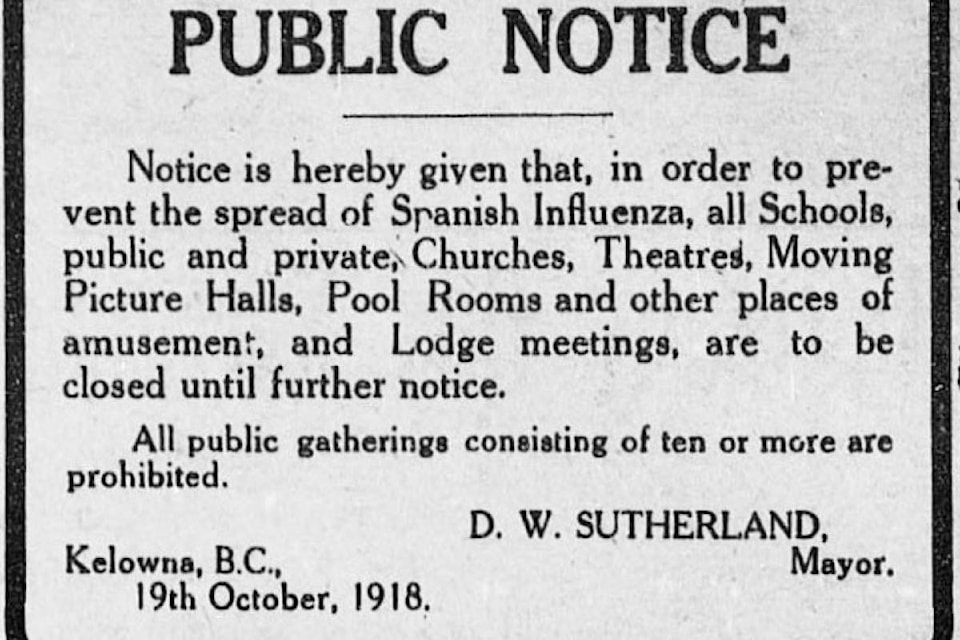As a lethal illness swept around the world, the health advice printed in the Ashcroft Journal was straightforward. Keep sick people away from healthy ones. Use disinfectants everywhere and wash your hands frequently. Anyone who contracted the illness was told not to mingle with others for at least 10 days after first diagnosed, and to stay away from work for a longer period in severe cases. Cleanliness and ventilation were stressed, as was safe disposal of anything used to blow your nose.
The advice is something we have all heard regarding the COVID-19 virus. However, it was given more than 100 years ago, about the influenza pandemic that swept around the globe as World War I drew to a close, and appeared in the Journal on Oct. 26, 1918.
There are many parallels between the influenza pandemic of more than 100 years ago and the COVID-19 pandemic of 2020. Both started elsewhere and only gradually made their way to the area, then quickly took hold. Cleaning supplies ran out as people rushed to buy disinfectants. Public gatherings were banned, events were cancelled, schools were closed, people stayed at home, volunteers stepped forward to provide assistance, health care professionals fell victim to the disease, and some towns, including Kamloops, closed their city limits in an effort to curb the spread of the virus.
No one is sure where the 1918 flu pandemic started. Some historians point to the eastern United States, specifically New York, while others believe it may have found a fertile breeding ground in the large and overcrowded UK troop staging and hospital camp in Étaples, France.
It did not start in Spain, although the virus came to be known as the Spanish flu, probably because Spain—which was neutral during World War I—reported freely on the disease and its many victims, unlike other countries involved in the war, which tried to downplay such stories in order not to harm morale.
Wherever it started, it found a convenient host in the tens of thousands of soldiers moving around the world as the First World War entered its final year. The first outbreaks began in late 1917, and peaked in early 1918. However, it was the calm before the storm: a more virulent strain of the virus began appearing in August 1918.
The earlier outbreak seems not to have reached the Interior of B.C., and for a time the area was spared the ravages of the second wave, which appeared simultaneously in France, the eastern United States, Sierra Leone, and Ireland. Soon it was on the move, however, and by October 1918 it was being reported in the pages of the Journal.
“There is considerable sickness among the construction men on the P.G.E. [tracklaying on the Pacific Great Eastern Railway had reached 83 Mile House], and also among the Indians employed at the [Epsom] salts lake [near Clinton],” noted the paper in the issue of Oct. 19, 1918.
“The trouble seems to be an exaggerated form of cold and not Spanish ‘Flu’ as has been reported. As a measure of precaution the provincial police in Clinton has ordered all proprietors of stores, hotel, pool room, and all other places open to the public, to sprinkle their floors with a solution of strong disinfectant.”
A week later, on Oct. 26, an editorial in the Journal began on a positive note. “Although the Spanish influenza is causing much anxiety and considerable mortality in other parts of the province as well as in Canada … its ravages in the Interior, especially in the dry belt, is not so severe. There are a number of cases, but few deaths. In Ashcroft there has only been one death up to date.”
However, the native community was being hit hard. The one death noted was of a First Nations person, and the editorial stated that “There are a large number of Indians infected on the reserves, and in one case four or five were found in one cabin lying on the floor suffering from the disease.”
They were attended by Dr. H.A. Hopkins, who was described as “a very busy man right now,” and it was noted that “most of the cases reported from the 59 Mile post on the P.G.E. construction, are doing well and are recovering. Cases that were reported from Lillooet, Pavilion, and Clinton were only slight and the patients have recovered.”
The piece also stated that “The School in Ashcroft has not yet been closed as it was considered safer for the children to be at school than running the streets.” One fact that was noted was that children did not seem as susceptible to the disease as “the grown up people.”
The devastating nature of this second strain of influenza was already becoming apparent, however. The provincial health office placed limits on the size of public gatherings, and soon the Ashcroft and Clinton schools were both closed. A number of new cases of influenza were reported in the Lillooet and Clinton areas, and health warnings about the need for cleanliness, and the thorough use of disinfectants, caused a run on supplies.
“The local stocks of eucalyptus oil, lysol, crude carbolic acid, and other disinfectants are completely sold out and it is hoped that the spread of the epidemic may be checked,” noted the Journal on Nov. 2. “All places of public resort are being thoroughly disinfected every day under orders of the provincial police, and the people are staying at home as much as possible.”
To be continued
editorial@accjournal.ca
Like us on Facebook and follow us on Twitter
